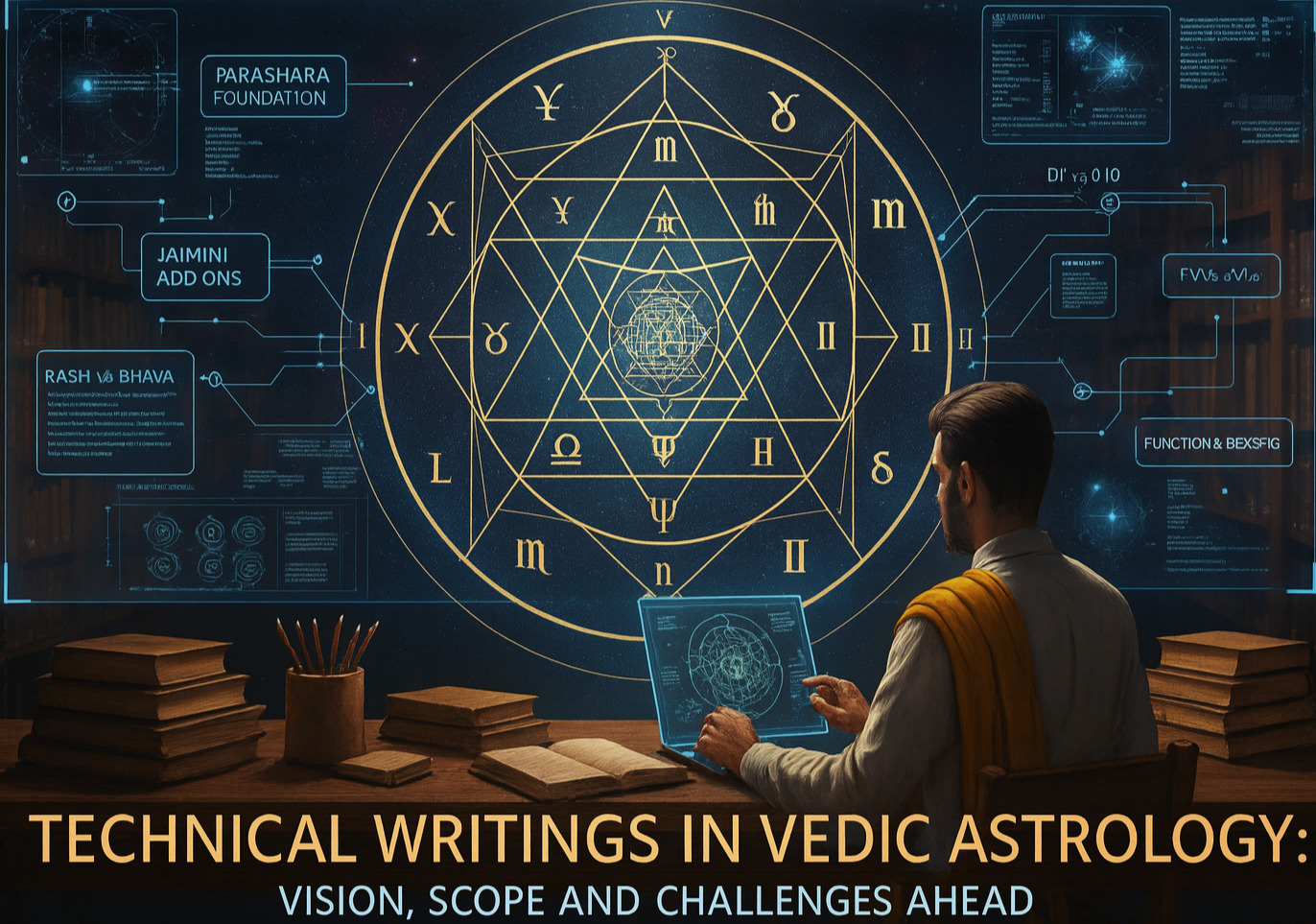Serious students always reach this point: “I’ve read scattered notes, watched videos, asked teachers… but where is the one clean, technical, modern, no-nonsense guide to Jyotish?” The honest answer is: writing such a guide is hard. Not because Vedic astrology is vague, but because it is layered — mathematical, symbolic, karmic, and contextual all at once. That is exactly why technical writings in Vedic astrology need a clear vision and a realistic scope.
This article is about that meta-level view. If you’ve ever wanted to create your own course, book, blog series, or “Much Needed Astro” style knowledge base, this is the blueprint. We’ll see what can be written down easily, what actually needs 300–600 pages, and which parts can only be absorbed through live chart work.
We’ll also keep it completely Jyotish-centric — Parashara foundation, Jaimini add-ons, dashas propose / transits dispose, D1 vs D9 vs D10, functional benefic vs functional malefic, and the eternal “rashi vs bhava” confusion. Because technical writings in Vedic astrology that skip these pillars become motivational essays, not real astrology.
Why Technical Writings in Vedic Astrology Are So Demanding
Good Jyotish writing is not just “here’s what the 7th house means.” Anyone can do that. The real difficulty is teaching synthesis: how the 7th house changes when Venus is combust, when the 7th lord is in a dusthana, when Rahu aspects it, when the Navamsa disagrees, and when the dasha lord doesn’t care because it’s busy doing a 10th house storyline.
That is why mature teachers hesitate to “just write a book.” They know that a chart is not one rule — it is repetition across reference lagnas, dashas, transits, vargas, and ashtakavarga. And every time you add one more rule, you must show where it doesn’t work. Students rarely see that part in public content, which is why they think astrology “contradicts itself.” It doesn’t; it just demands context.
So the first boundary condition is: a single, short article cannot hold the full teaching. That’s why you create a series of technical writings in Vedic astrology — small, coherent units that together build a predictable system.
Long-Term Vision: The Comprehensive Vedic Astrology Book
You can think of the long-term vision as: “One day I will write the 300–600 page treatise that actually explains what I know.” That’s realistic. Two decades of chart-reading, consulting, rectification attempts, and dasha/transit tracking cannot be compressed into a 30-page PDF without losing the soul of the work.
A comprehensive Vedic astrology book for serious students must do at least four things:
- Pin down core grammar: planets, signs, houses, aspects, functional nature from lagna.
- Explain timing: dashas propose, transits dispose; why Vimshottari “works,” and how to read Saturn/Jupiter cycles against it.
- Integrate vargas: D1 for promise, D9 for strength and dharma of the promise, D10 for career unfolding — and admit openly when D9 disagrees with D1.
- Show real charts: not hypothetical ones. Actual charts where a yoga on paper did not deliver because dignity was poor or the dasha never came.
That is why a serious book ends up long. You’re not just listing yogas; you’re teaching how to read a yoga in 2025 for an Indian, English-speaking, digitally employed person. That needs desh, kaal, paristhiti.
Short-Term Plan: Technical Discussions and Bridge Articles
While that long book is in the future, the fastest way to build authority is to publish Vedic astrology technical lessons — focused, digestible pieces that clear up one confusion at a time. For example:
- “Dashas and divisional charts for prediction: which one leads?”
- “Parashara and Jaimini synthesis: when to switch lenses.”
- “Difference between rashi and bhava: why your planet ‘moved’ in chalit.”
- “When does a yoga on paper actually deliver?”
- “Functional benefic vs natural benefic — which do we trust more?”
Each such article becomes a brick. Ten bricks become a module. Three modules become a course. And one day, all of them become the backbone of your comprehensive text.
Notice what we are doing here: we are not trying to “simplify” Jyotish, we are trying to sequence it. That’s the core of all technical writings in Vedic astrology — build an order, not a pile.
Handling Contradictions: Why Classical Texts Seem to Disagree
One of the biggest pains for intermediate students is: “Parashara said this, Jaimini seems to do something else, BPHS doesn’t mention Kaal Sarp, but modern astrologers swear by it.” This is where your writing must be kinder than the older texts.
Here’s the teacher move:
- Name the lens: “This is from a Parashara lens,” or “this is a Jaimini rashi-drishti situation.”
- Fix the chart: always show the lagna, not just the rule. Functional nature depends on lagna.
- Time it: “This will matter only in the dasha of the involved planet or when a slow transit activates it.”
- Cross-check varga: if D9 throws a tantrum, say so. Readers respect honesty.
Contradictions dissolve when you keep telling the reader: “This rule was meant for this context. Outside that, don’t over-apply it.”
What to Prioritize in Advanced Jyotish Writing
Since you cannot write everything at once, prioritize what gives the most predictive leverage:
- Dashas and divisional charts for prediction: students crave timing; give them clear dasha → transit → event logic.
- Rashi vs bhava: this single topic reduces 30% of beginner confusion. Your article already hinted at it — keep it in.
- Functional benefic/malefic by lagna: this is how we stop saying “Saturn is bad” and start saying “for Taurus lagna, Saturn is actually good.”
- Upachaya logic: 3/6/10/11 get better with time — this encourages readers and fights fatalism.
- Nodes through the lens of the dispositor: Rahu/Ketu behave through the sign lord and the planet they conjoin. Students must hear this often.
When your technical writings in Vedic astrology keep circling back to these pillars, your readers slowly build an internal Jyotish operating system.
Challenges Ahead: Depth, Time, and Reader Expectations
Let’s be blunt: a lot of people want “advanced Jyotish” in 10 pages. That’s not happening. If you write honestly, your articles will be longer, and that’s fine. You’re writing for people who want to become practitioners, not people who want to know their “lucky color for Tuesday.”
So set expectations inside the article: “If you feel overwhelmed, that’s normal. Jyotish takes time. It’s not meant to be memorized in one sitting; it’s meant to be lived with.” That line alone reduces reader anxiety and makes them trust you.
Also, keep reminding them: no single rule is absolute. Dashas propose, transits dispose. Yogas coexist. Repetition across reference lagnas is confirmation. D1 sets the story, D9 and D10 refine it. Ashtakavarga can rescue a weak dignity. Combustion can block delivery. This is the grammar your readers must hear again and again.
Important Notes
Why is it so hard to write a single, concise, complete book?
Because Jyotish is modular. You can explain houses in 30 pages, but as soon as you add combust Mercury in the 10th, Rahu in the 3rd, and a Saturn antardasha, you need another 30 pages of exceptions. A real book must teach principles and their failure conditions. That’s why it takes 300–600 pages.
Are technical posts only for advanced readers?
They’re mostly for intermediate students — the ones who already know houses/signs/planets and now want to understand delivery: when will a planet actually act? Your short technical posts become the bridge between beginner texts and real chart work.
Do we have to include rashi–bhava distinctions every time?
Almost yes. Many perceived “contradictions” come from not seeing that a planet at, say, 2° Aquarius could still belong to the previous house in chalit. Technical writings in Vedic astrology should normalize this and show example charts.
What about remedies?
Mention them, but never promise miracles. Always test functional beneficence first. Strengthen only what is safe to strengthen. Emphasize discipline, service, and timing as the real remedies.
FAQ
Can I teach Parashara and Jaimini together?
Yes, but name the lens. Say “this is Parashara-based” when you use house-lord logic, and “this is Jaimini-based” when you use rashi drishti or special lagnas (HL, GL, AL). Mixing without labelling is what confuses readers.
How do I know if my article is too long?
If each section answers one clear student frustration, it’s not too long. Students of astrology are used to depth. They get frustrated only when depth is unclear, not when it is long.
Is it okay to publish before I have the full 500-page book?
Absolutely. In fact, you should. Publishing technical pieces first will show you which topics land, which examples people ask about, and which parts need more charts. Your audience helps you shape the eventual book.
How do I keep from sounding dogmatic?
Keep saying: “in practice, confirm this in the chart.” “Check dignity.” “Check dasha.” “And check navamsa.” This is the anti-dogma chorus. It also happens to be good astrology.
Keep Learning with Much Needed Astro
If this piece made you think, “Okay, this is the level of clarity I want for all Jyotish topics,” then you’re in the right place. That’s the whole point of Much Needed Astro — to turn advanced Vedic astrology into something you can actually apply, without fear-mongering, without superstition, and without dumbing it down.
Stay with Much Needed Astro for more structured technical writings in Vedic astrology, real chart logic, and a teacher’s voice that keeps saying what everyone forgets: dashas propose, transits dispose — and you still have free will. No fluff, no drama, just Jyotish you can grow with.



